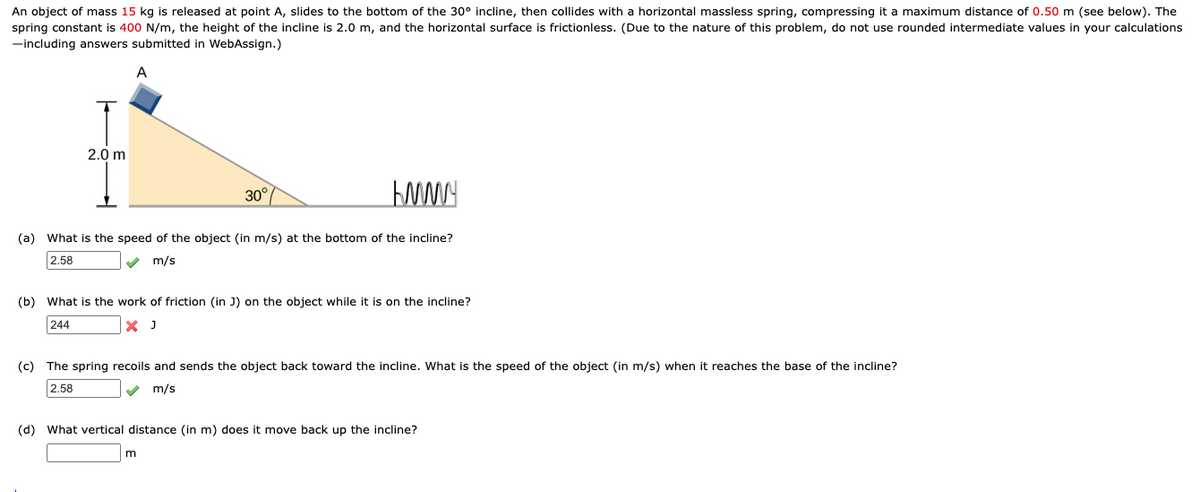spring constant is 400 N/m, the height of the incline is 2.0o m, and the horizontal surface is frictionless. (Due to the nature of this problem, do not use rounded intermediate values in your calculations -including answers submitted in WebAssign.) 2.0 m 30° (a) What is the speed of the object (in m/s) at the bottom of the incline? 2.58 v m/s (b) What is the work of friction (in J) on the object while it is on the incline? 244 (c) The spring recoils and sends the object back toward the incline. What is the speed of the object (in m/s) when it reaches the base of the incline? 2.58 v m/s (d) What vertical distance (in m) does move back up the incline? m
spring constant is 400 N/m, the height of the incline is 2.0o m, and the horizontal surface is frictionless. (Due to the nature of this problem, do not use rounded intermediate values in your calculations -including answers submitted in WebAssign.) 2.0 m 30° (a) What is the speed of the object (in m/s) at the bottom of the incline? 2.58 v m/s (b) What is the work of friction (in J) on the object while it is on the incline? 244 (c) The spring recoils and sends the object back toward the incline. What is the speed of the object (in m/s) when it reaches the base of the incline? 2.58 v m/s (d) What vertical distance (in m) does move back up the incline? m
University Physics Volume 1
18th Edition
ISBN:9781938168277
Author:William Moebs, Samuel J. Ling, Jeff Sanny
Publisher:William Moebs, Samuel J. Ling, Jeff Sanny
Chapter8: Potential Energy And Conservation Of Energy
Section: Chapter Questions
Problem 79AP: Consider a block of mass 0.200 kg attached to a spring of spring constant 100 N/m. The block is...
Related questions
Question

Transcribed Image Text:An object of mass 15 kg is released at point A, slides to the bottom of the 30° incline, then collides with a horizontal massless spring, compressing it a maximum distance of 0.50 m (see below). The
spring constant is 400 N/m, the height of the incline is 2.0 m, and the horizontal surface is frictionless. (Due to the nature of this problem, do not use rounded intermediate values in your calculations
-including answers submitted in WebAssign.)
2.0 m
30°
(a) What is the speed of the object (in m/s) at the bottom of the incline?
2.58
m/s
(b) What is the work of friction (in J) on the object while it is on the incline?
244
X J
(c) The spring recoils and sends the object back toward the incline. What is the speed of the object (in m/s) when it reaches the base of the incline?
2.58
m/s
(d) What vertical distance (in m) does it move back up the incline?
Expert Solution
This question has been solved!
Explore an expertly crafted, step-by-step solution for a thorough understanding of key concepts.
This is a popular solution!
Trending now
This is a popular solution!
Step by step
Solved in 3 steps with 3 images

Recommended textbooks for you

University Physics Volume 1
Physics
ISBN:
9781938168277
Author:
William Moebs, Samuel J. Ling, Jeff Sanny
Publisher:
OpenStax - Rice University

College Physics
Physics
ISBN:
9781305952300
Author:
Raymond A. Serway, Chris Vuille
Publisher:
Cengage Learning

Physics for Scientists and Engineers
Physics
ISBN:
9781337553278
Author:
Raymond A. Serway, John W. Jewett
Publisher:
Cengage Learning

University Physics Volume 1
Physics
ISBN:
9781938168277
Author:
William Moebs, Samuel J. Ling, Jeff Sanny
Publisher:
OpenStax - Rice University

College Physics
Physics
ISBN:
9781305952300
Author:
Raymond A. Serway, Chris Vuille
Publisher:
Cengage Learning

Physics for Scientists and Engineers
Physics
ISBN:
9781337553278
Author:
Raymond A. Serway, John W. Jewett
Publisher:
Cengage Learning

Physics for Scientists and Engineers with Modern …
Physics
ISBN:
9781337553292
Author:
Raymond A. Serway, John W. Jewett
Publisher:
Cengage Learning

Principles of Physics: A Calculus-Based Text
Physics
ISBN:
9781133104261
Author:
Raymond A. Serway, John W. Jewett
Publisher:
Cengage Learning

Physics for Scientists and Engineers: Foundations…
Physics
ISBN:
9781133939146
Author:
Katz, Debora M.
Publisher:
Cengage Learning